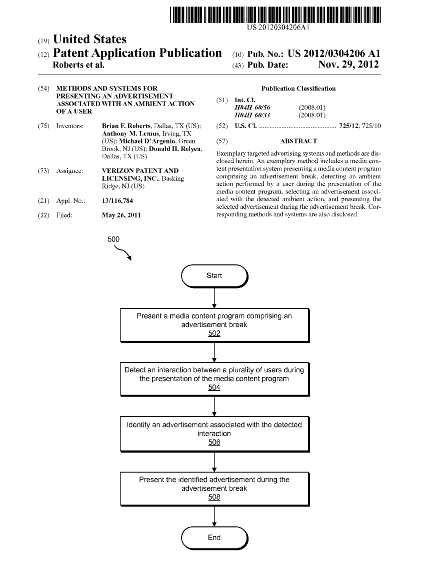The following patent was published on November 29, 2012 and concerns a set-top box capable of monitoring its users “ambient actions” to target advertisements with greater accuracy.
METHODS AND SYSTEMS FOR PRESENTING AN ADVERTISEMENT ASSOCIATED WITH AN AMBIENT ACTION OF A USER
- 14 pages
- November 29, 2012
Exemplary targeted advertising systems and methods are disclosed herein. An exemplary method includes a media content presentation system presenting a media content program comprising an advertisement break, detecting an ambient action performed by a user during the presentation of the media content program, selecting an advertisement associated with the detected ambient action, and presenting the selected advertisement during the advertisement break. Corresponding methods and systems are also disclosed.
…
[0001] The advent of set-top box devices and other media content access devices (“access devices”) has provided users with access to a large number and variety of media content choices. For example, a user may choose to experience a variety of broadcast television programs, pay-per-view services, video-on-demand programming, Internet services, and audio programming via a set-top box device. Such access devices have also provided service providers (e.g., television service providers) with an ability to present advertising to users. For example, designated advertisement channels may be used to deliver various advertisements to an access device for presentation to one or more users. In some examples, advertising may be targeted to a specific user or group of users of an access device.
[0002] However, traditional targeted advertising systems and methods may base targeted advertising solely on user profile information associated with a media content access device and/or user interactions directly with the media content access device. Accordingly, traditional targeted advertising systems and methods fail to account for one or more ambient actions of a user while the user is experiencing media content using a media content access device. For example, if a user is watching a television program, a traditional targeted advertising system fails to account for what the user is doing (e.g., eating, interacting with another user, sleeping, etc.) while the user is watching the television program. This limits the effectiveness, personalization, and/or adaptability of the targeted advertising.
…
[0015] Detection facility 104 may be configured to detect an ambient action performed by a user during the presentation of a media content program (e.g., by presentation facility 102). As used herein, the term “ambient action” may refer to any action performed by a user that is independent of and/or not directed at a media content access device presenting media content. For example, an ambient action may include any suitable action of a user during a presentation of a media content program by a media content access device, whether the user is actively experiencing (e.g., actively viewing) or passively experiencing (e.g., passively viewing and/or listening while the user is doing something else) the media content being presented.
[0016] To illustrate, an exemplary ambient action may include the user eating, exercising, laughing, reading, sleeping, talking, singing, humming, cleaning, playing a musical instrument, performing any other suitable action, and/or engaging in any other physical activity during the presentation of the media content. In certain examples, the ambient action may include an interaction by the user with another user (e.g., another user physically located in the same room as the user). To illustrate, the ambient action may include the user talking to, cuddling with, fighting with, wrestling with, playing a game with, competing with, and/or otherwise interacting with the other user. In further examples, the ambient action may include the user interacting with a separate media content access device (e.g., a media content access device separate from the media content access device presenting the media content). For example, the ambient action may include the user interacting with a mobile device (e.g., a mobile phone device, a tablet computer, a laptop computer, etc.) during the presentation of a media content program by a set-top box (“STB”) device.


